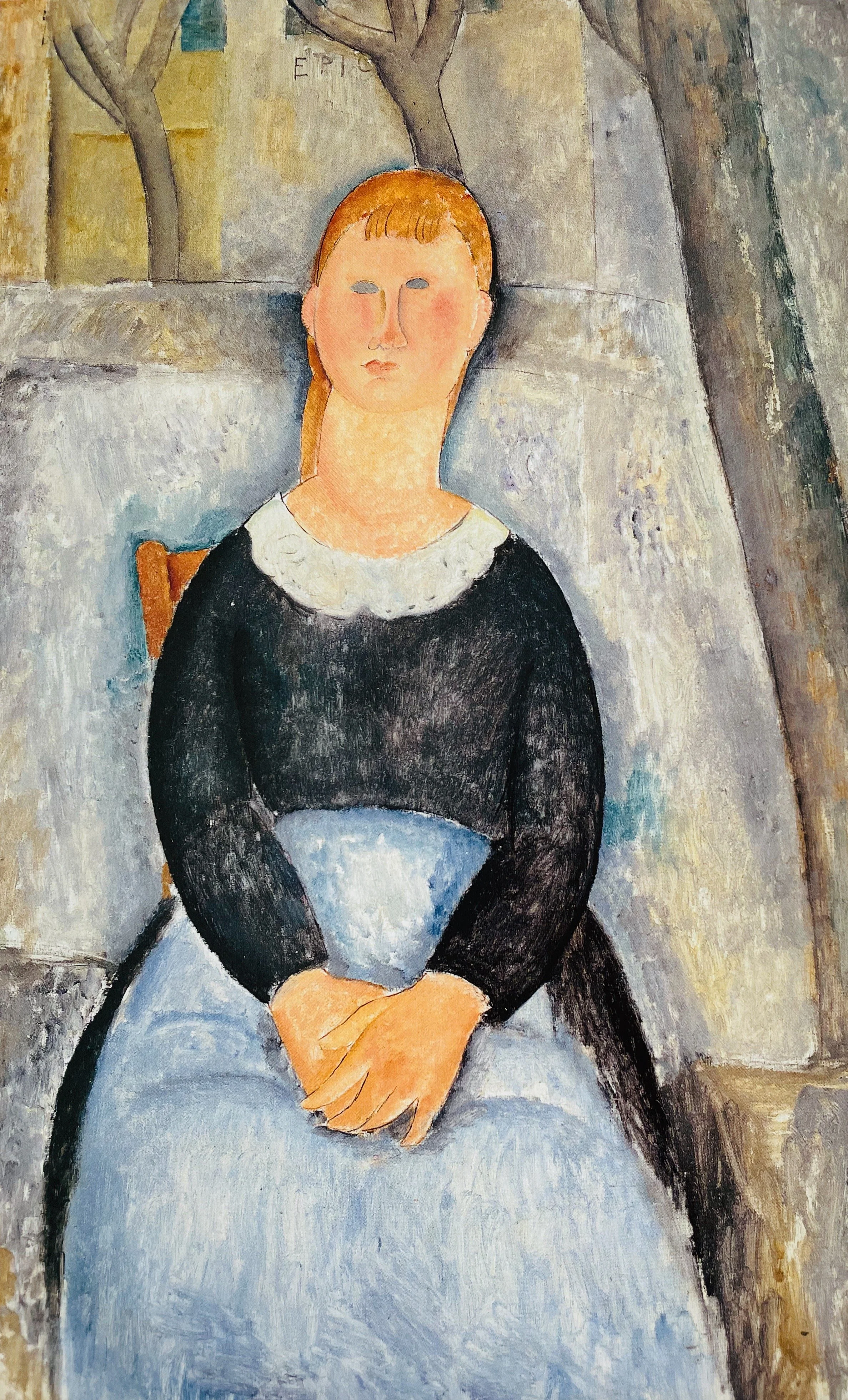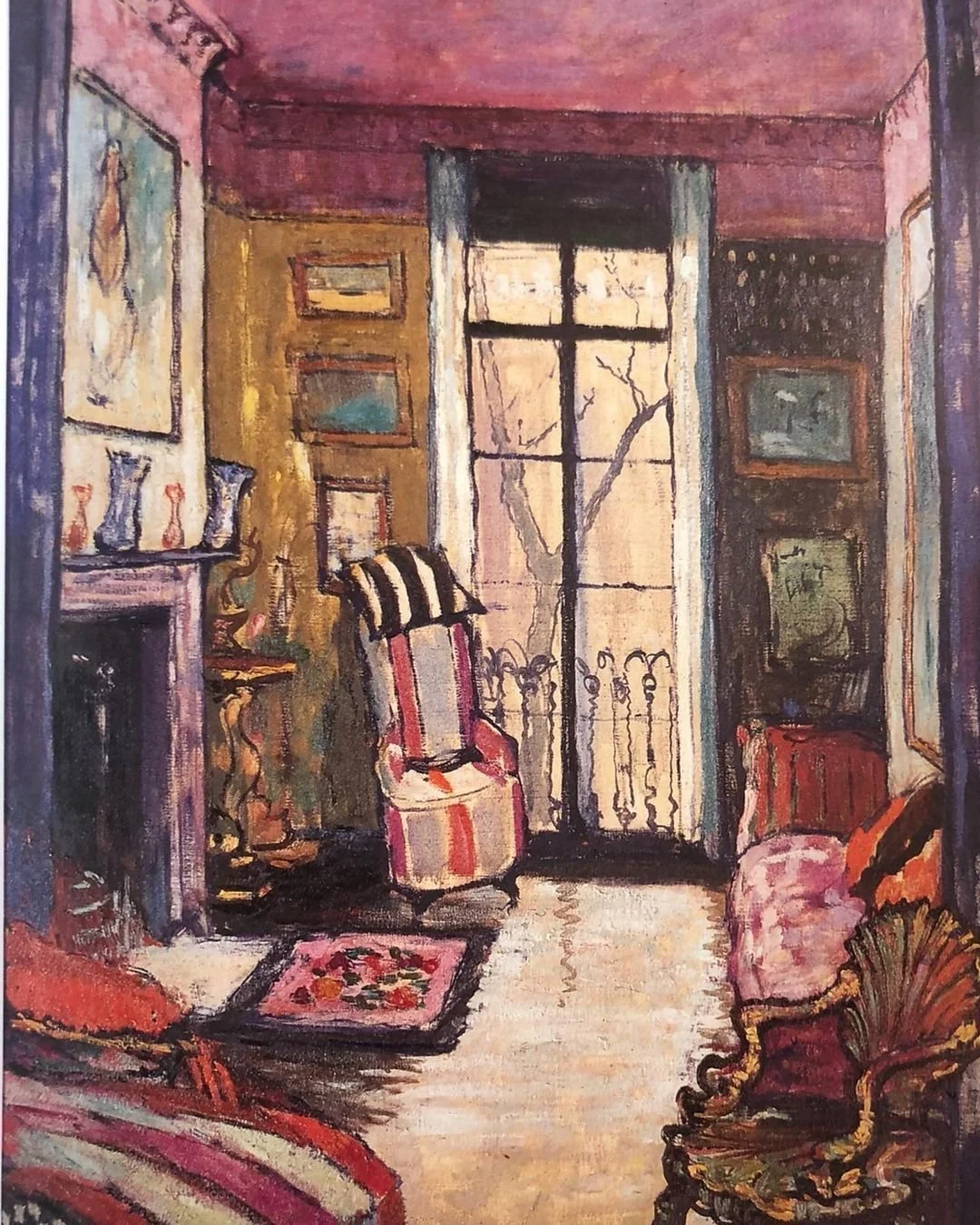Osbert and Sacheverell Sitwell - 2
(Fig. 1) La Belle Épicière, 1918. Private collection
October 4, 2022
The Peasant Girl of Carlyle Square
(The sequel to “The Missed Opportunity,” published in Spotlight, July 2022)
There, caught in the artist’s net, is the cautious wry-necked peasant girl of Northern France . . . with the lank hair of the forsaken, with hands clasped, resting stoutly on a wooden chair in a transparency of vaporous blue . . .
(Osbert Sitwell, in his memoir Laughter in the Next Room)
In advance of the August 1919 opening of French Art 1914–19, at the Mansard Gallery, London, Sacheverell and Osbert Sitwell, the exhibition’s organizers, were invited by Léopold Zborowski to purchase at cost a Modigliani painting of their choosing. They selected a work that Osbert later referred to as the “Peasant Girl” for the modest sum of four pounds. This was a very good price considering that earlier that year Modigliani’s Portrait de Dédie, 1918, sold for the equivalent of twenty-two pounds in the sale of the Eugène Descaves collection at the Hôtel Drouot in Paris.
The painting prominently graced the mantel in the drawing room of the brothers’ posh Carlyle Square residence where they hosted an intimate dinner to celebrate their father’s sixtieth birthday in late January 1920. Devised to secure Sir George Sitwell’s financial support in purchasing Zborowski’s holdings of Modigliani paintings, the evening took a fateful turn when a derisive reaction to the portrait, unsolicitedly offered by their father’s friend, rattled the risk-averse Sir George, effectively sinking the contemplated deal.
Until now, the Sitwell work has not been positively identified. None of the nine Modigliani paintings in the 1919 exhibition checklist bears a title resembling Peasant Girl, indicating that the work was not shown at the Mansard Gallery. There are compelling clues, however, that point to La Belle Epicière, 1918 (Fig. 1) as the painting once owned by the Sitwells. The brothers were poets and Osbert’s lyrical description of their portrait, quoted above, seems to aptly capture its formal qualities and psychological aspects.
Perhaps an explanation for the Sitwells’ appreciation of this particular work can be found in Osbert’s affectionate recollection of Mrs. Powell, their beloved, long-time cook, which sounds strikingly similar to his interpretation of Modigliani’s subject. A farmer’s daughter, Mrs. Powell had been sent out as a young girl to work in service in the homes of several aristocratic families before arriving at the Sitwell residence in London. Describing her, Osbert writes:
With her she brought an air of happy, primitive abundance . . . tales of pigs and geese and poultry. . . Sometimes, on a rich autumn evening, I would see her sitting at the open window . . . and her hands would rest on the warm, golden sill. She liked to take the air in a doorway, as an animal does, and in it, or indeed in the window, she would remain framed by wooden rectangle or square as in a portrait, and there would be something monumental about her, calm, benign, good, beautiful.
(Fig. 2) Ethel Sands, The Drawing-room at 2 Carlyle Square, Chelsea, c. 1920–25. Location unknown
A watercolor by Ethel Sands (fig. 2), a friend of the Sitwells, depicts their Carlyle Square drawing room circa 1920–25 and lends additional support for the identification of La Belle Épicière. Though the composition is hazy, a faint outline of a seated figure is seen in the painting that hangs over the mantel. The model’s frontal position, with her hands resting in her lap, and the color palette are clearly reminiscent of La Belle Épicière, as are the curving shapes that mimic those of the trees above her head in the background.
In Osbert’s memoir, first published in 1948, he recalls how he and his brother were persuaded by an artist friend to sell him their Modigliani painting sometime in the mid- to late-1920s. His lasting regret over its sale is evident as he muses: “I do not know where The Peasant Girl hangs now. . .” If indeed it was La Belle Épicière that the brothers owned, Osbert need not have worried: the portrait went on to be included in the most prestigious exhibitions of Modigliani’s work, beginning with the XVII Biennale de Venezia in 1930, and, most recently, the 2017 retrospective at the Tate Museum in London. Today she is recognized as a preeminent example of Modigliani’s humanist and sympathetic portraits of simple country folk, painted during his stay in the Midi from April 1918 through May 1919.
Leslie Koot
Sources
Hôtel Drouot, Paris, Tableaux, aquarelles, pastels, dessins: Collection Eugène Descaves, March 28, 1919, lot 60.
Osbert Sitwell, Laughter in the Next Room (London: Macmillan & Company Ltd., 1948), 52–5, 150, 165–7. Internet archive link.
Jonathan Fryer, “London and the War,” in The Sitwells and the Arts of the 1920s and 1930s exh. cat. (London: National Portrait Gallery in association with University of Texas Press, Austin, 1996), 45.
Paintings referenced:
Portrait de Dédie, 1918, Musée National d'Art Moderne, Centre Pompidou.
Special thanks to Christine Beevers, Archivist at Renishaw Hall, for her assistance with our research and for bringing the Ethel Sands painting to our attention.
The Modigliani Initiative



